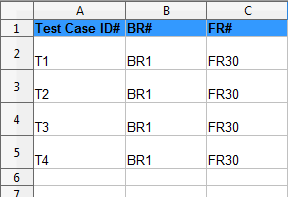Requirement Traceability Matrix
Requirement Traceability matrix is just a Table which is used to trace user requirements with test cases. In other words, with the help of this matrix we can trace, what requirements has been covered by tester and what are missed while creating test cases for the planned version.
Requirement Traceability Matrix-Parameters Includes:-
- Business Requirement ID#
- Functional Requirement ID#
- Test Case ID#
Suppose we have provided Business Requirement Document (BRD) and Technical Requirement Document (TRD) or Functional Requirement Document (FRD) and tester has been used these documents to create test cases.
For example:
Lets suppose Business Requirement ID# for the login/logout module is BR1 and Functional Requirement ID# for the login functionality is FR30.
Suppose tester has created four test cases for login functionality, these IDs are T1,T2,T3 and T4.
Test case spreadsheet

Requirement Traceability Matrix (RTM)
:
Types of Traceability Matrix:
Forward Traceability: This matrix is used to check project progress in desired direction. It make sure that each requirement is applied to the product and each requirement tested thoroughly. It maps requirements to test cases.
Backward Traceability: This matrix is used to ensure whether current product remains on right track and we are not expanding the scope of the product by adding code, design elements and test that is not specified in the requirements.It maps test cases to requirements.
Bi-directional Traceability: This is the combination of Forward and Backward traceability matrices.
Advantages of Requirement Traceability Matrix:
1. It confirms 100% test coverage.
2. It highlights any missing requirement and document inconsistency.
3. It gives complete filled defect and test case execution status.
4. It helps in analyzing and estimating the tester rework if any changes occur in requirement.
0 Comment(s)